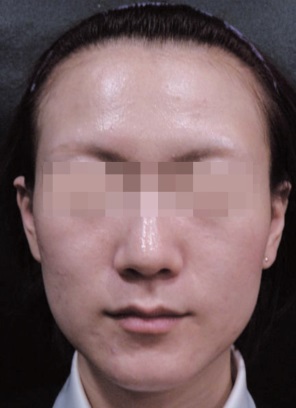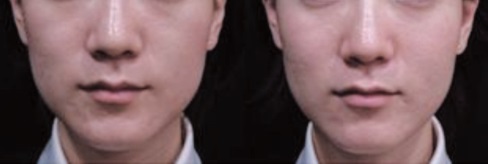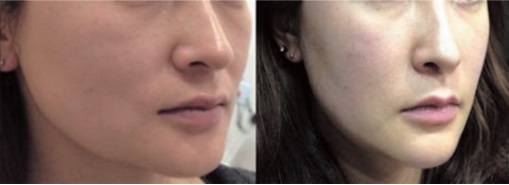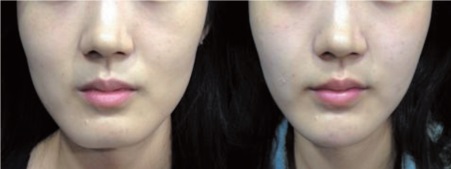The meaning of Images by Filler and the probability of filler procedures was explained previously. Once again, Images by filler is the procedure of injecting the standard 5ml of filler to any areas available for filler injection as wanted by patients, including forehead, glabella, temple, nose, tear trough, Indian band, submalar hollow, nasolabial fold, sunken cheek, marionette line and chin. The procedure sites are determined by consultation with the patient and doctor’s design. Both the patient’s request as well as clinician’s recommendation is considered in the process.
This chapter will discuss the selection of patients appropriate for image filler and the selection of filler. Let’s first look at appropriate cases. <Case 1> is a 28-year-old female patient, who has nasolabial fold, sunken cheek and Indian band. She did not want forehead and nose augmentation. I chose a somewhat hard type filler to make a volume, and Juvederm® Voluma®was used with a 23G cannula.
[Ad. ▶Ultra Skin/Pastelle - Manufacturer: WONTECH(www.wtlaser.com)]

Figure 1. <Case 1> Before the procedure
Producing a volume while preserving the original facial contour made her appearance generally bright and vivid, while improving the facial contour at the same time. As in this case, people with several grooves and folds may benefit a lot from images by filler when they have well-defined facial features and a rather long facial contour. Figure 2 shows the picture taken before and after the procedure, and Figure 3 shows a similar facial type also before and after the procedure.

Figure 2. <Case 1> Before and after the procedure (procedure sites: Indian band, nasolabial fold and cheek).
Figure 3, Figure 4 is a 40-year-old woman, who wanted filler procedure for the Indian band, sunken cheek and nasolabial fold generated by aging process. I also agreed with the patient and performed images by filler for rejuvenation.

Figure 3. <Case 2> Before and after the procedure (procedure sites: Indian band, nasolabial fold and cheek).

Figure 4. <Case 2> Before and after the procedure (Rt. side view)
These are also people who can expect benefit from the filler procedure. These cases show you changing facial shape. There is a case with severe nasojugal groove (tear trough and Indian band), nasolabial fold. But, images by filler can make change her face.(Figure 5)

Figure 5. <Case 4> 35/F (procedure sites: nasojugal groove, cheek and nasolabial fold)
Images by filler is not limited to Indian band, nasolabial fold and cheek. Let’s see cases of correcting asymmetric facial shape.
This 27-year-old woman had a somewhat lean face with rather severe asymmetry. The procedure sites were Indian band, nasolabial fold, cheek, Marionette line and chin. The left marionette line was corrected to a reverse T shape. The asymmetry was much improved and the facial contour became softer, with appropriate volume, making younger and brighter appearance. And the face looked smaller. At the same time, she also gained soft V line (U line), which is preferred by Koreans.(Figure 6)

Figure 6. <Case 5> 27/F before and after the procedure (procedure sites: Indian band, nasolabial fold, cheek, marionette line and chin)
I prefer cannula for most of procedures; 27G or 23G cannula is used for forehead, glabella, temples, nose, tear trough, Indian folds, nasolabial folds, cheek, marionette line and so on. Needle is used only when necessary, such as for nasal root, chin and lips. I prefer cannula because of minimizing bruise, safety and a kind of subcision. In rare cases, puncture site may become bruised, in which case the bruise can be covered by make-up. In order to minimize pain, supratrochlear n. supra & infraorbital nerve block can be applied with a topical anesthetic cream, and I prefer products containing lidocaine.
The type of filler can be selected according to the site of procedure. Since most images by filler is volume replacement, volumizing fillers are preferred. I personally use Juvederm® Voluma® for the forehead, glabella, temples, nose, Indian band, nasolabial fold, cheek, chin and Marionette line and relatively soft Juvederm® Ultra® or Volbella® for tear trough, eye roll, and lips enhancement. Juvederm® Voluma® is suitable for obtaining a sufficient volumizing effect and is easy to control the amount of injection. Compared to hard HA fillers of similar properties, Voluma® can be operated with a 27G cannula (although a little bit dense), and the soft property enables more beautiful shape. The maintenance period is one and a half year, which is also good. Juvederm® Voluma® and Ultra® contain lidocaine, which is very helpful for reducing pain. I prefer Teosyal® Kiss® for lips enhancement. Compared to soft HA fillers for the lips, Teosyal® Kiss® provides good volumizing effect and maintains the shape relatively well for a considerably long period of time. One drawback is the fact that it does not contain lidocaine. The above mentioned filler types are personal preferences, not an absolute standard of selection.
I explained Images by Filler by giving concrete examples; cases of long facial contour with many problems on the face, small and long face requiring volume replacement in some facial areas, and asymmetric face. All of these cases were good candidates of images by filler.
The facial treatment zone can be categorized broadly to T zone and U zone, depending on the site of procedure. T zone includes the forehead, glabella, nose and chin, while U zone includes zygoma, Indian band, cheek, nasolabial folds, marionette line and chin. Most of the above cases received filler injection in the U zone. Other types of patients, including T zone images by filler patients and patients who visited after receiving facial contouring surgery will be introduced in the next chapter.
- To be continued -
▶ Previous Artlcle : #1. Summary of Images by Filler
▶ Next Artlcle : #3.T zone Procedures and Other Case Types





















